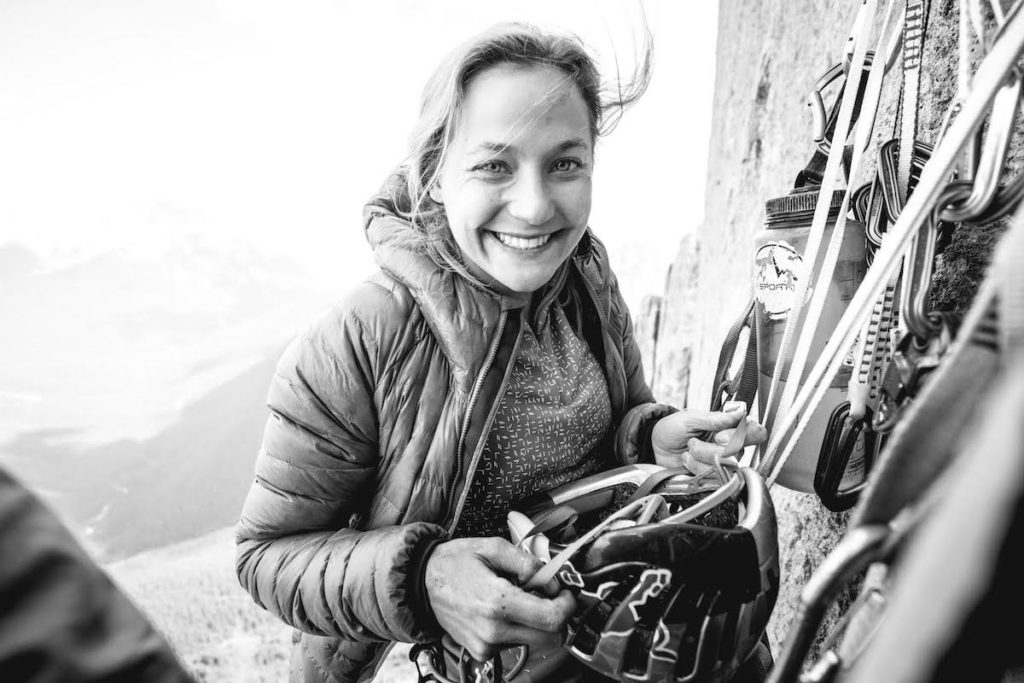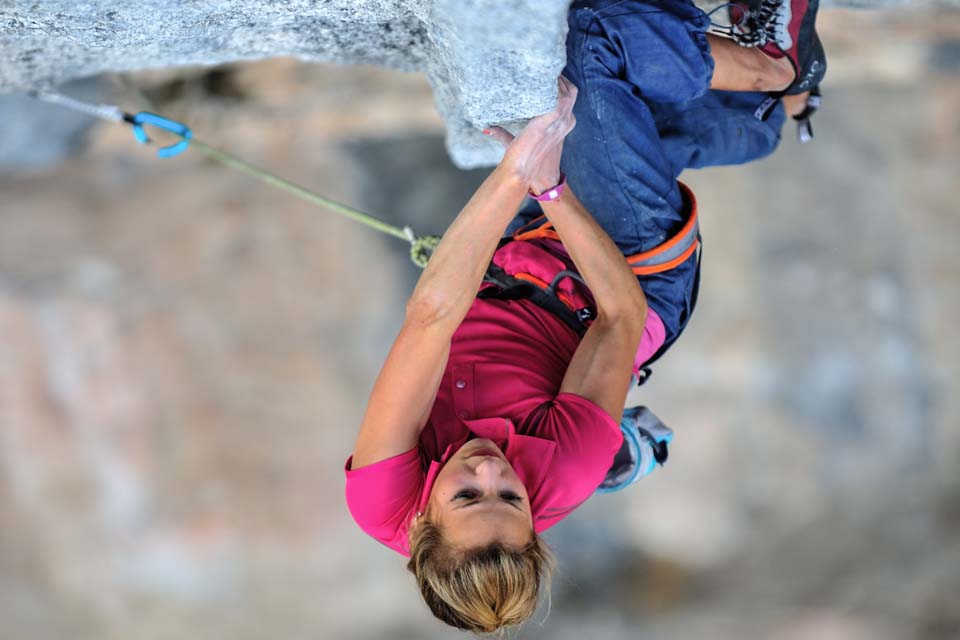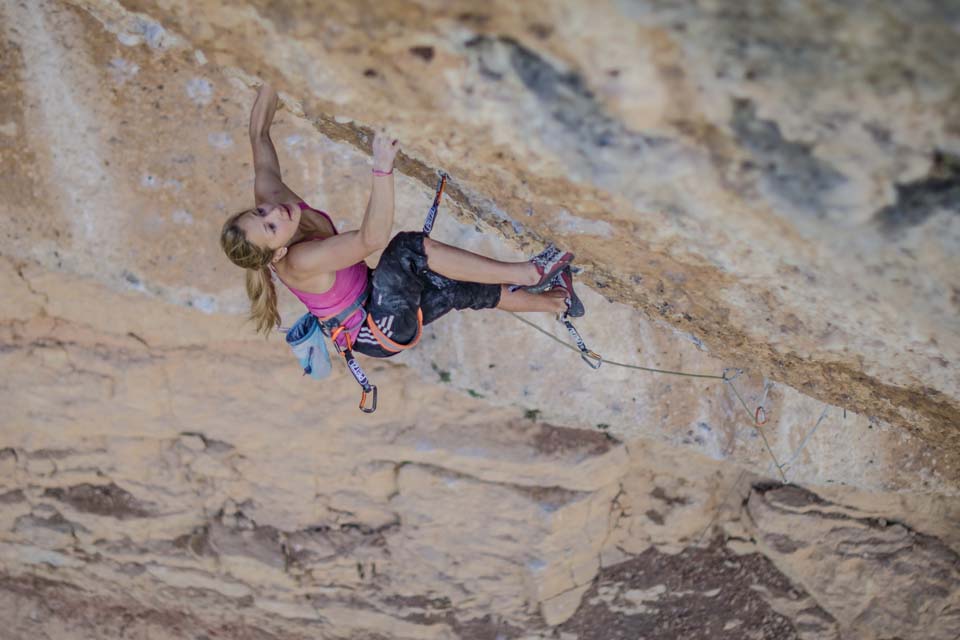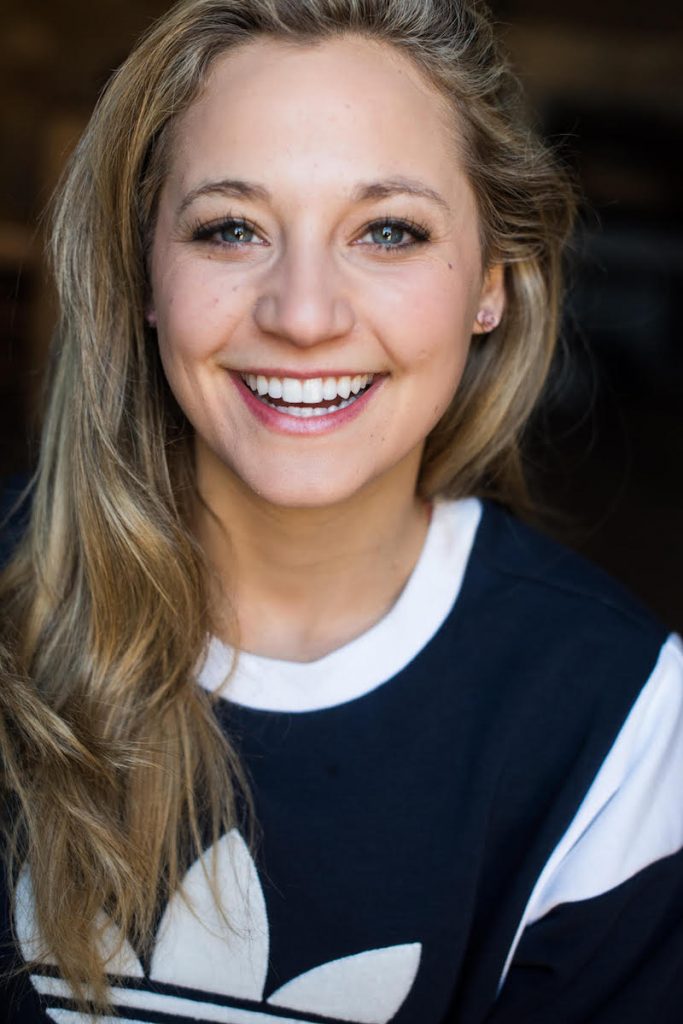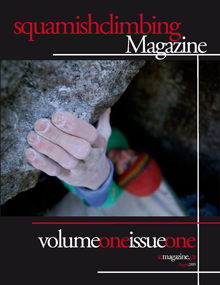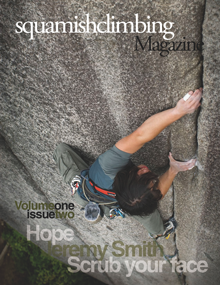Starting to climb at the age of six years old, Sasha Digiulian has been a crusher since the beginning. She was the first North American women to climb 5.14d and third woman in the world to accomplish the grade. She is also a three time US National Champion and won the Climbing World Championship in 2011. Recently graduating from Columbia University with a degree in Non-fiction writing and Business, Sasha has turned her focus towards her climbing career. Last summer, Sasha DiGiulian completed Sonnie Trotters Canadian Trilogy, a series of three 5.14 big walls in the Canadian Rockies.
We had a chance to talk to her before she takes the stage this coming Saturday at the 22nd Annual Vancouver International Mountain Film Festival and here is what she had to say.
Thanks for taking the time to chat with us. We are very excited about you closing out the 2019 VIMFF. Let’s start with your summer in the Canadian Rockies! How did you like living in Banff and what was the best thing about living in Canada for the summer?
I loved being in Banff. I am a dual citizen with Canada and my family is from the East Coast. I grew up going to Mont Tremblant frequently, yet had not spent too much time in Western Canada. Banff is one of the most beautiful places I’ve ever been!
You completed Sonnie Trotter’s Triple Crown, which is no small feat! What made you want to take on this challenge?
In early February, 2018, I had just come off of a big ice climbing trip on the Upper Peninsula of Michigan and I was excited to keep expanding my comfort zones and to set my sights on my next goal to train for. I came across the Rock and Ice magazine that Sonnie Trotter was on the cover of, climbing Mount Yamnuska, and it caught my attention. I flipped through to the article, which Trotter wrote about the project and I was hooked by what seemed like a big challenge and full on adventure.

Blue Jeans Direct, Mount Yamnuska, Canada. Photo by Priscilla Mewborne courtesy of VIMFF ©
Is there anything that really sticks out about the experience looking back?
All of the doubt that preceded it, the hard, long days, and the camaraderie and partnerships that I grew while I was there; I felt like I developed a little family and I am so thankful for the community.
What was it like getting belayed by Canadian legend Mike Doyle?
Climbing with Mike Doyle is always an engaging, motivating, and fun experience. I’ve known Doyle since back in my youth climbing competition days when he was the coach for team canada. I looked up to him as a master of the craft, and have stayed in touch with him through the years. We had been trying to link our schedules to actually go out climbing together for a while, and it was nice for the ends to finally meet – and in such an extreme way – our days were certainly full on! Doyle is such an encouraging and reliable partner, he is certainly a large part of my successful journey on this project; and he completed the trilogy, too!
The Canadian Rockies take a lot of hiking and fitness in order to climb well. Did you come fit or did you build up your hiking endurance throughout the experience?
I definitely left fitter than I ever have been in my career. Leading up to it, I had a lot of curve balls come my way, and while I was on a committed training plan, sometimes preparing to excel in the mountains is hard to do – you have to expect that you will gain some of that specific fitness when you are actually there, on the project, and going for it. Adrenaline and drive help a lot!
Do you think the commitment to even get on some of those multi-pitches makes you try harder in the moment or did you feel the same amount of pressure as everyday cragging?
The commitment to getting to the base of the multi-pitches certainly upped the ante! Pre-dawn alarm clocks, massive hikes, and fatigue were a huge part of this journey that looking back at, I am so thankful for. But, the days that we just went out cragging, I was like, oh my gosh, this is so chill, sport climbing is so chill! Haha.
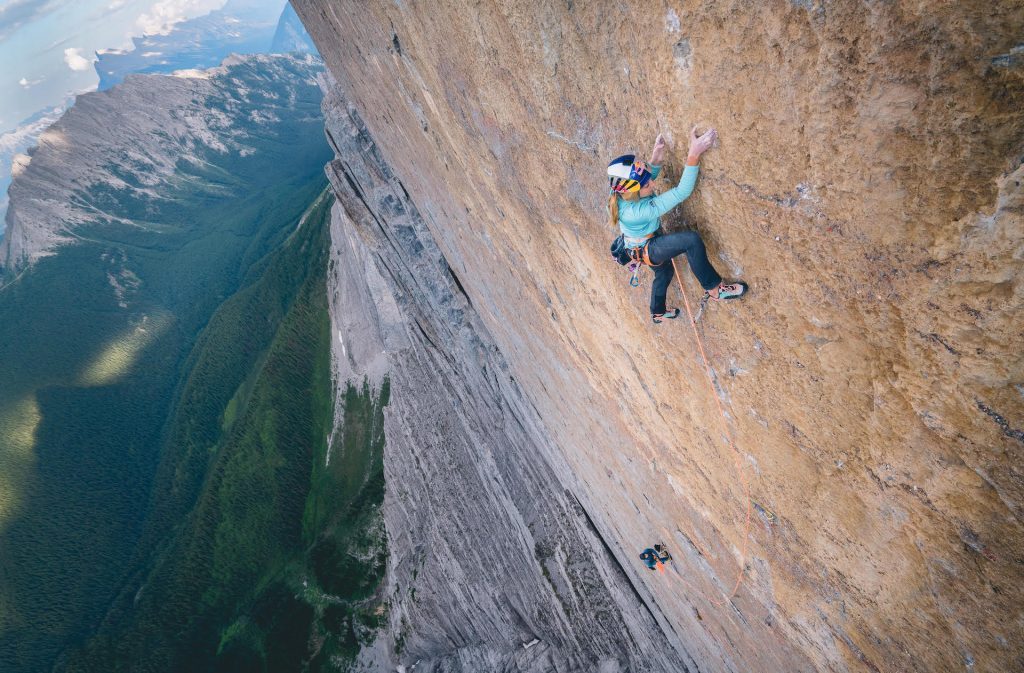
The Shining Uncut. Photo by Peter Hoang courtesy of VIMFF ©
What are your goals for the upcoming year? Any more summers in the Rockies?
I just got back from a trip through Cuba, and am taking off in a couple days to El Salto, Mexico. I have a few smaller projects on trips like this throughout the upcoming months, and then one of my big projects this summer is a 5.14 mutlti-pitch off the west coast of Central Africa. I would like to return to climb in Canada in June and or August!
Your family has big ties to Canada. Can you tell us a bit about your Canadian roots and what it means for you to spend time in Canada?
My mom and her family grew up in Montreal. When my mom met my Dad and they married and had my brother and me, she moved to Washington DC to raise us together with my Dad who lived there. However, we maintained a large presence in Canada; we spent several weeks every winter, spring, and summer at our house in Mont Tremblant; skiing and also I climbed in Val David, Montagne D’argent, and nearby granite areas to our house up there. My cousins are also like my extended siblings; we are super close. A lot of them are living in Toronto; however, I also have some family in Calgary, Vancouver, and Winnipeg!
Since graduating, you have turned your efforts more towards your climbing career. Can you tell us a bit about this and what it all means for you?
Graduating from Columbia University enabled me to focus again primarily on climbing and big outdoor projects. While in school, my climbing sometimes had to take the back seat because I was committed to doing well academically as well, and doing anything half way doesn’t really make sense to me. On school breaks, that’s when I went on climbing trips outside, but living in Manhattan and enduring a rigorous academic schedule, it was hard to find a balance to train and to commit as much time to climbing as I would like to. I had two full-time jobs; being a full-time student, and also my professional career as an athlete. Climbing is what has paid all of my bills since I was 17 and I am really thankful for the opportunities that I have had; though, it comes with sacrifices, time management, learning to prioritize certain things; and what, and school was definitely challenging to my career at times. The professors at Columbia were not bending to my schedule as a climber – if I missed class, it was entirely on me, and not really encouraged. So I just tried to do my best.
With climbing and training and social events, the job of being a professional climber seems more involved that in the past. How do you deal with the pressure or does it come naturally to you?
I focus on surrounding myself by positive people, staying in my lane, and doing my best.
Does social media and commitments ever take away from the experience of focusing on climbing and training?
I wouldn’t consider social media taking away from the experience or focus, but I certainly feel like career commitments can complicate my schedule and make it harder to find a fluid routine. I feel really healthy and optimal when I am at home in Boulder, focused, training, and eating well. Though, it is hard to be home consistently; partially my own doing – for wanting to travel, explore, and climb in different areas around the world, which is a huge passion of mine and part of my commitment to climbing; but then also events or engagements that I take part in – whether contractual obligations or otherwise- it can cause a non-conventional approach to my schedule and I just try to stay on top of my training and climbing needs no matter where I am. Traveling can be grueling on the body, though, and while I am really grateful for my job, it’s not always as simple as “I climb rocks for a living.” I think that the profession is a lot more complex than that; and it doesn’t have to be… but I want it to be. So I try to create my own path and define what my profession looks like given what I want to pursuit.
You recently injured yourself. How do you stay motivated when getting injured?
Actually, during the Canadian Trilogy I injured myself as well; I sprained my AC Joint in my left shoulder. Thankfully, I had one of the world’s best physical therapists to work with – Fabienne Moser – out of Banff. Then, yes; recently I fractured my Fibula in my right leg. This was really frustrating to me at first because I felt like I was in really good shape and I just wanted to take advantage of that and perform well outside. However, I think it was the Universe’s way of telling me to slow down. I was doing a lot at the time – I was just coming off of a trip through the Middle East and Europe, directly after the Canadian Trilogy – and I was a bit run down and scattered. I took the time while injured to be at home, ground myself, focus on strengthening my weaknesses, with the goal of coming back stronger. Together with my team of physical therapists and my personal trainer – Joslynne Corridor, I think that we accomplished this. Now I am really excited for 2019!
Is injury just a part of the game or do you think it causes more stress because of goals and obligations to your sponsors etc?
Injuries can be a part of the game when you are pushing yourself to your optimal ability every day. However, they don’t have to be. Since my last two major injuries this year, I am really committed to treating my body with preventative measures and prioritizing recovery and optimization of my antagonist muscles and body functionality to the same degree as I put the hours in towards improving. Stretching and recovery, and treating your body well – from replenishing with the right fuel, to listening to the aches and pains – are a big part of the overall progression.
Competition was very much a part or your climbing when you were younger but now it doesn’t play a role in your climbing. Reflecting back, what did you learn from the competition scene and why did you end up choosing to focus your time outside?
From competition climbing I learned how to set goals, stay committed to seeing these goals through, time management, and also putting yourself on the line on a single climb- trying your best and committing.
Looking at how climbing has grown over the past few years, what does that mean to your stewardship as a professional climber and the influence you may have on others?
I am really thankful for my career and know that it took all of the climbers that came before me, and the people that have been a part of my life along the way – to realize the point at which I am at today. No one has success alone – and I recognize the privileges I have been awarded and the opportunities I have been presented along the way; I have just tried to make the most of them and put my best self forward. I believe that this platform that I have is a privilege, and I should use my voice to affect the change that I believe in.
I would be remiss if I did not ask about the controversy last year surrounding Joe Kinder and the comments made on instagram. Reflecting back, what was the biggest learning you took from those moments?
It is a privilege to make a living from your passion. But being a professional climber is beyond just climbing hard lines on rock. It is about being a representative of the sport, encouraging others, lifting people up, and giving back to the community. I stand by my decision to stand up for myself on my platform. It was not my first course of action, as all of the preceding attempts to end what was an ongoing, hurtful harassment, went ignored. I shared what was published online already. I did not choose to be a part of a hurtful, one-sided “joke,” that I was not a part of. I believe that it is important to stand up for yourself, and I hope that in doing so, I could encourage other people to draw their own lines against their bullies as well. Cyber bullying or bullying in any form is not acceptable. That is the bottom line. When it comes to representing a sport, being a role model for a community, that follows the same rule. We need to lift each other up, not push others down, for any reason.
Being in the spotlight at that time came with both positive and negative engagement on social media. How do you deal with negative engagement as a person and as a professional?
No one is bulletproof. I know that it would be an impossible battle to convince the whole world to agree with me; whether knowing me or not. What upsets me is when people make negative assumptions about my character before ever even meeting me. But that is not something I can control; the opinions of others are up to each individual to make – but I can try my best to tell my story, be a genuine human, and try to set as positive of an example as I believe I am capable of. As for my personal life – I choose to surround myself by positivity; by friends that are my friends because of who I am, not because of any name significance or opportunistic origin. I get to meet a lot of people through climbing, and I am grateful for that. The community at whole is like family; it is amazing to have a global community through climbing – this shared passion that connects us. My family and my close friends ground me – in these relationships, loyalty, trust, and positivity are really important pillars to me.
In the end of it all, was there any closure between you and Joe Kinder?
We have not been in contact. The only closure that I can say is that bullying of any kind; cyber bullying or other forms of harassment, is not acceptable and should not be tolerated in our community. I am thankful for the support and love that I received through the time at which I stood up against this; it was one of the most challenging episodes I’ve ever experienced in climbing as it felt like a really divisive time in which people formulated their own opinions, not even knowing the whole story.
I think since then there is more discussion regarding how women are treated and equality between men and women in the climbing scene. How do you think things have gotten better over the past few years and what else do you think still needs to change?
Climbing is a progressive sport in the way that women and men are paid equally through competitions and sponsorship runs on a marketing budget, so women and men both have the opportunity to build out their careers at a somewhat equal playing field. There are still far more male professional climbers than women. However, as the sport grows, there has been an incredible increase in female participation, and with that, the levels that women are climbing, just continue to be pushed. Angela Eiter sending the first 9b (5.15b) ever achieved by a woman; that was such a high light to women in sports. She is one of my all time inspirations. Though, I think that we can still continue to improve; coverage of female athletes in media and videos, support, and equal treatment.
Throughout my career, I’ve always battled through reattribution to my success which has only contributed to this feeling of having more than I deserve. I know that I work really hard. I do my best, and I also have grown up with this sport. Since I was 16, I’ve felt like I’ve inhabited somewhat of a limelight in the industry, and that has been really challenging at times – feeling the need to defend the reason that I am sponsored, my own accomplishments, and my passion for climbing as being genuine – this may not be a female-specific problem, but I do believe that it is a more prevalent battle across female athletes than men. There is certainly a boys-club in climbing and that is okay – we all have the right to define our place and to be who we are; it’s just, we should all support each other and not try to knock each other down. That is not what encourages growth across a community.
As female athletes, we all have a right to a seat at the table and there’s not just one opening. The way forward is for men to support women, but also for women to support women, and for women to support men. We all need to work together to foster a positive impact.
Thanks again for your time. We are really looking forward to your presentation at VIMFF! Tickets for Sasha and the VIMFF Finale can be purchased here.
—
Our content would not be possible without our sponsors Flashed Climbing, The Hive Bouldering Gym, Climb Base 5, Climb On Squamish, the Vancouver International Mountain Film Festival, Kilter Grips, Bolder Climbing Community, and Gneiss Climbing. Be sure to give them some love!!
